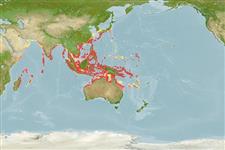Common names from other countries
Environment: milieu / climate zone / depth range / distribution range
Écologie
marin démersal; profondeur 1 - 40 m (Ref. 86942). Tropical; 36°N - 24°S, 48°E - 169°E
Indo-West Pacific: Indonesia (Java ) to central China, including Taiwan.
Taille / Poids / Âge
Maturity: Lm ? range ? - ? cm
Max length : 35.2 cm WD mâle / non sexé; (Ref. 111772); 54.5 cm WD (female)
This demersal species is found inshore and on continental shelf to at least 50 m depth. It feeds on small bony fishes and crustaceans (Ref. 11889, 114953). Max size may reach up to 85 cm WD (Ref. 47613). Ovoviviparous (Ref. 50449). Litters of only 1 pup (Ref. 114953).
Life cycle and mating behavior
Maturité | Reproduction | Frai | Œufs | Fécondité | Larves
Exhibit ovoviparity (aplacental viviparity), with embryos feeding initially on yolk, then receiving additional nourishment from the mother by indirect absorption of uterine fluid enriched with mucus, fat or protein through specialised structures (Ref. 50449). Distinct pairing with embrace (Ref. 205).
Last, P.R. and L.J.V. Compagno, 1999. Dasyatididae. Stingrays. p. 1479-1505. In K.E. Carpenter and V.H. Niem (eds.) FAO species identification guide for fishery purposes. The living marine resources of the Western Central Pacific. Vol. 3. Batoid fishes, chimaeras and bony fishes part 1 (Elopidae to Linophrynidae). FAO, Rome. (Ref. 9840)
Statut dans la liste rouge de l'IUCN (Ref. 130435)
CITES (Ref. 128078)
Not Evaluated
Menace pour l'homme
Harmless
Utilisations par l'homme
Pêcheries: intérêt commercial mineur
Plus d'informations
RéférencesAquacultureProfil d'aquacultureSouchesGénétiqueElectrophoresesHéritabilitéPathologiesTraitementMass conversion
CollaborateursImagesStamps, Coins Misc.SonsCiguateraVitesseType de nageSurface branchialeOtolithesCerveauxVision
Outils
Articles particuliers
Télécharger en XML
Sources Internet
Estimates based on models
Preferred temperature (Ref.
115969): 24.7 - 29.1, mean 28.2 (based on 1060 cells).
Phylogenetic diversity index (Ref.
82804): PD
50 = 0.5010 [Uniqueness, from 0.5 = low to 2.0 = high].
Bayesian length-weight: a=0.00479 (0.00344 - 0.00666), b=3.07 (2.98 - 3.16), in cm Total Length, based on LWR estimates for this species (Ref.
93245).
Niveau trophique (Ref.
69278): 4.5 ±0.80 se; based on food items.
Résilience (Ref.
120179): Faible, temps minimum de doublement de population : 4,5 à 14 années (Assuming fecundity<100).
Fishing Vulnerability (Ref.
59153): Very high vulnerability (90 of 100).
